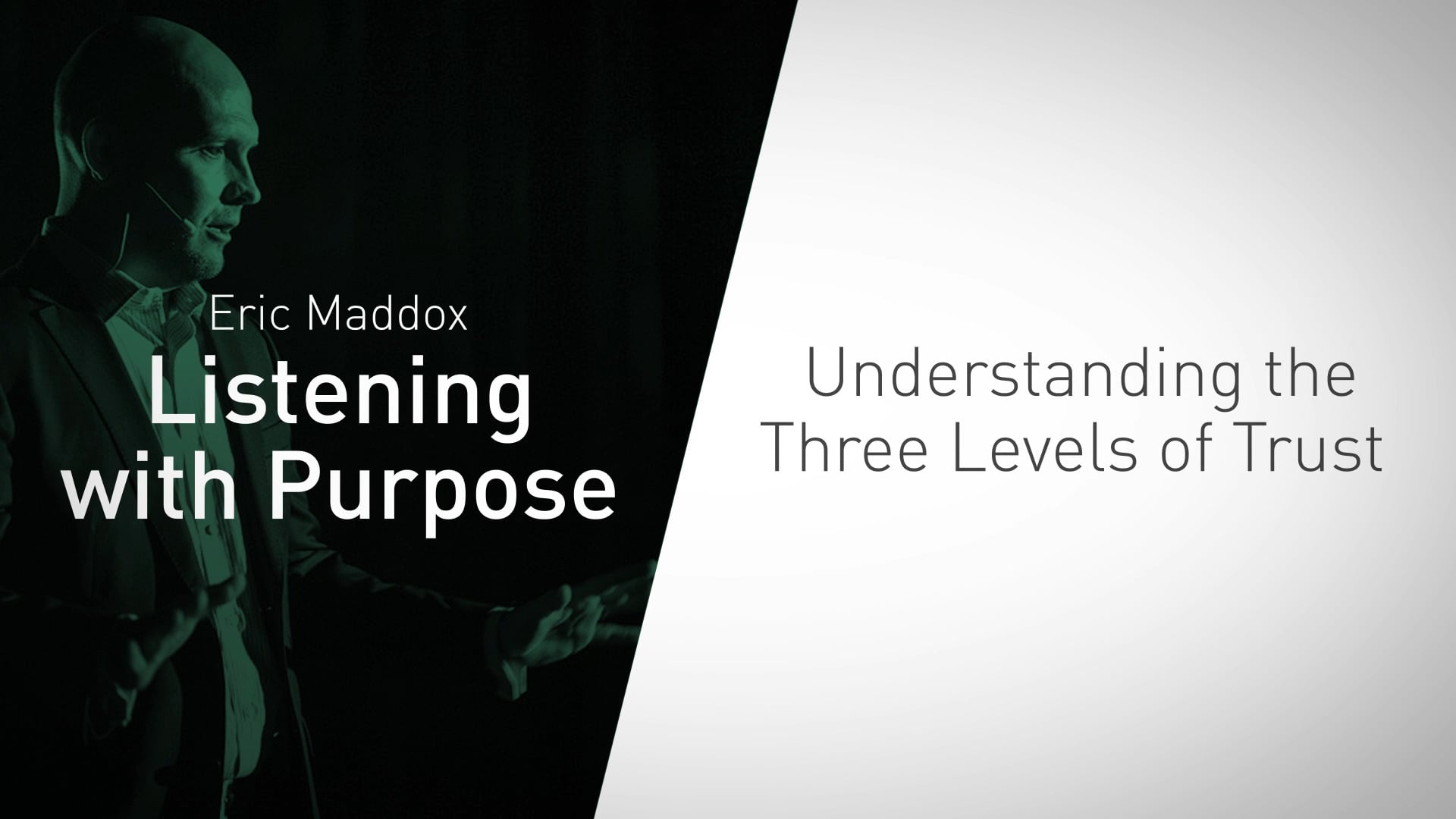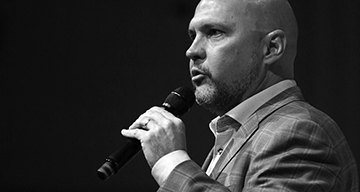-
Trust, Stages and Distractions
Class 1 Resources: Trust, Stages and Distractions
These resources will help your branch team build a high level of trust by mitigating distractions as well as showing you how to walk off your stage and onto your client's.
-
About Eric Maddox
-
The Three Levels of Trust
-
Understanding Stages
-
Removing Listening Distractions
-
Frequently Asked Questions
About Eric Maddox
About Eric Maddox: Personal story and professional background
The Three Levels of Trust
The Three Levels of Trust
 Watch
WatchUnderstanding the Three Levels of Trust | Transcript
Trust impacts our ability to influence others. Understand the levels of trust and learn how to build more trust with clients and prospects.
Advisor Edge Program MaterialApril 2, 2023The Three Levels of Trust
Before you can increase trust and add more value, you need to understand the levels of trust.
Understanding Stages
Understanding Stages
Advisor Edge Program MaterialUnderstanding Stages: Yours and Mine
Understand the concept of stages and the importance of operating on a client's stage.
 Watch
WatchListening with Purpose: The Concept of Stages | Transcript
See how the ability to move from your stage to a client's or prospect's stage is key to building deep levels of trust.
 Watch
WatchStages Mistakes #1: But I’m a Problem Solver | Transcript
Learn how to recognize when you've moved from a client's stage back to yours in order to solve a problem.
 Watch
WatchStage Mistakes #2: How Do I Stay On Their Stage? | Transcript
Explore how you can stay on a client's stage by continually seeking to understand their perspective.
Removing Listening Distractions
Removing Listening Distractions
Advisor Edge Program MaterialApril 2, 2023Removing Listening Distractions
Learn how to remove distractions and build deeper levels of trust.
 Watch
Watch6 Categories of Listening Distractions Overview | Transcript
Eric Maddox discusses his background, how he developed Empathy-Based Listening and how this program can set you on the road to success.
 Watch
WatchCategory 1 Distractions: Immediate Non-Biased | Transcript
Learn what category one distractions are and how to eliminate them.
 Watch
WatchCategory 2 Distractions: Personal Non-Biased | Transcript
Explore how personal non-biased can get in the way of listening.
 Watch
WatchCategory 3 Distractions: Lack of Topic Familiarity | Transcript
See how unknown terms can derail you and what to do when you encounter them.
 Watch
WatchCategory 4 Distractions: Biases Towards the Individual | Transcript
Learn how filtering conversations through a bias can lower your ability to listen.
 Watch
WatchCategory 5 Distractions: Thinking about Our Goals, Objectives or Agenda | Transcript
Focusing on your agenda is a major distraction. Learn how to mitigate this large distraction.
 Watch
WatchCategory 6 Distractions: Thinking About What We Want to Say Next | Transcript
Rather than proving your worth, explore ways demonstrate that your focus in on your listeners.
Frequently Asked Questions
Frequently Asked Questions
 Watch
WatchShould I Tell My Story? | Transcript
Shared stories are a great way to relate. Learn some of the best ways to share yours.

When Do We Deliver Our Value Proposition? | Transcript
See how to spot cues that tell you have moved onto a client's or prospect's stage.

How Do I Keep My Focus in a Group Setting? | Transcript
Learn how to use discovery questions to manage a group discussion.

Should I Maintain Eye Contact? | Transcript
Eye contact demonstrates your interest. Explore tactics for maintaining eye contact.

How Do I Apply Empathy Based Listening When Starting a Meeting? | Transcript
Follow these simple strategies that brings your agenda to your client's stage.

How Do I Build Trust in a Virtual Meeting? | Transcript
See how to create a virtual meeting that has as much impact as an in-person one.

Won't Empathy Based Listening Extend the Time Spent in Meetings? | Transcript
Explore how Empathy Based Listening and moving to another's stage can help you uncover clients’ needs faster.
-
-
Identifying Breadcrumbs
Class 2 Resources: Identifying Breadcrumbs
Clients and prospects often drop conversational "breadcrumbs." These resources will help your branch team identify and pick up those breadcrumbs to home in on clients and prospects' concerns and goals.
-
The Importance of Conversational Breadcrumbs
-
Frequently Asked Questions
The Importance of Conversational Breadcrumbs
The Importance of Conversational Breadcrumbs
Advisor Edge Program MaterialDecember 2, 2022The Importance of Conversational Breadcrumbs
Breadcrumbs can take many forms. Learn how to identify the different categories of breadcrumbs and how to respond.

10 Categories of Breadcrumbs Overview | Transcript
Learn how to recognize and act on key breadcrumbs to improve your listening skills.

Category 1: Subjective Statement Breadcrumb | Transcript
Learn how you can use subjective statements from clients and prospects to understand their perspective.

Category 2: Exclamatory Statement Breadcrumb | Transcript
Exclamatory statements are the easiest to recognize. Understand what they signal.

Category 3: Speculative Statement Breadcrumb | Transcript
See how these statements help you prove that you care about a client's or prospect's opinion.

Category 4: Leads Breadcrumb | Transcript
Lead breadcrumbs show excitement. Learn how to tap into that excitement.

Category 5: Needs Breadcrumb | Transcript
See why picking up these breadcrumbs is key to engaging on a person's stage.
 Watch
WatchCategory 6: Change of Direction Breadcrumb | Transcript
Learn how to respond when a client or prospect suddenly changes the subject mid-conversation.

Category 7: Questions Breadcrumb | Transcript
These breadcrumbs are not as simple as they seem. See how to discover what really matters.

Category 8: Comparison Statement Breadcrumb | Transcript
Recognize what clients and prospects are looking for when they make comparison statements.

Category 9: No Better Time Than the Present Breadcrumb | Transcript
These are topics a person brings up then puts off. Explore ways to follow up on these statements.

Category 10: Rejection Breadcrumb | Transcript
Learn how to discover what's behind a rejection and how to accept it.
Frequently Asked Questions
Frequently Asked Questions

How Do I Keep Track of Multiple Breadcrumbs? | Transcript
See how you can avoid being overwhelmed by multiple breadcrumbs.

How Do I Keep Discovery From Turning into Interrogation? | Transcript
Explore how verbal cues can help guide your discovery.

When Addressing a Speculative Statement, When Should I Give My Opinion vs. Discover? | Transcript
Speculative statements may feel like questions. Understand what the client is really asking.

If a Category 9 Breadcrumb Is Deflected, What Should I Do? | Transcript
Learn what to do if a client or prospects side steps the breadcrumb you picked up.

Asking Multiple Questions to Identify Breadcrumbs Seems Time Consuming? | Transcript
Time matters. Understand how Empathy-Based Listening and this process can save time.

How do I Know If I Have Discovered the Breadcrumbs? | Transcript
Recognize when you've done enough discovery and moved to a client or prospect's stage.

How do I Navigate a Change of Direction? | Transcript
See how to keep on a client or prospect's stage when the conversation is shifted.
-
-
Empathetic Listening in Action
Class 3 Resources: Empathetic Listening in Action
Take action on what you learned with these resources and by partnering with your Edward Jones Team.
-
Analyze Your Book
-
Align Heritage Planning and My Priorities
-
Partner With MFS to Schedule a Seminar
-
Frequently Asked Questions
Analyze Your Book
MFS Team Directory for Edward Jones Internal Specialists
Set up a meeting with your Edward Jones Team and request a walkthrough of our Build with Purpose presentation. You will learn how to analyze your current book of business and client base, realign or reallocate your clients' portfolios based on their goals, needs and risk tolerance and help position yourself for long-term growth.
Align Heritage Planning and My Priorities
MFS Heritage Planning®MFS Heritage Planning & Edward Jones My Priorities In Action
Deepen client relationships by using MFS’ Heritage Planning info-sheets that align with the My Priorities tool. Jump start your journey to Goals-Based Advice through discovery and impact your branch today.
Partner With MFS to Schedule a Seminar
Seminar ResourcesClient Seminars for Edward Jones
Build stronger relationships with your clients and attract new prospects by hosting a seminar. View our seminar offerings.
Frequently Asked Questions
 Watch
WatchShould the My Priorities quiz be done individually or with a couple? | Transcript
224094q1 - 57009 - 2.28.26
 Watch
WatchIs it best to email the My Priorities quiz ahead of a client meeting or review in person? | Transcript
224094q2 - 57009 - 2.28.26
 Watch
WatchHow frequently should I walk my clients through the My Priorities quiz? | Transcript
224094q3 - 57009 - 2.28.26
 Watch
WatchHow do I navigate picking up breadcrumbs in a group setting? | Transcript
224094q7 - 57009 - 2.28.26
 Watch
WatchIs it best to use the My Priorities Tool with prospects or existing clients? | Transcript
224094q6 - 57009 - 2.28.26
 Watch
WatchHow does the My Priorities Tool relate to MoneyGuide Elite? | Transcript
224094q5 - 57009 - 2.28.26
-
Class 1 Resources: Trust, Stages and Distractions
These resources will help your branch team build a high level of trust by mitigating distractions as well as showing you how to walk off your stage and onto your client's.
-
About Eric Maddox
-
The Three Levels of Trust
-
Understanding Stages
-
Removing Listening Distractions
-
Frequently Asked Questions
About Eric Maddox
About Eric Maddox: Personal story and professional background

Eric Maddox: Personal Story and Professional Background Overview Video | Transcript
224094n - 56896 - 1.31.26
The Three Levels of Trust
The Three Levels of Trust

Understanding the Three Levels of Trust | Transcript
Trust impacts our ability to influence others. Understand the levels of trust and learn how to build more trust with clients and prospects.
The Three Levels of Trust
Before you can increase trust and add more value, you need to understand the levels of trust.
Understanding Stages
Understanding Stages
Understanding Stages: Yours and Mine
Understand the concept of stages and the importance of operating on a client's stage.

Listening with Purpose: The Concept of Stages | Transcript
See how the ability to move from your stage to a client's or prospect's stage is key to building deep levels of trust.

Stages Mistakes #1: But I’m a Problem Solver | Transcript
Learn how to recognize when you've moved from a client's stage back to yours in order to solve a problem.

Stage Mistakes #2: How Do I Stay On Their Stage? | Transcript
Explore how you can stay on a client's stage by continually seeking to understand their perspective.
Removing Listening Distractions
Removing Listening Distractions
Removing Listening Distractions
Learn how to remove distractions and build deeper levels of trust.

6 Categories of Listening Distractions Overview | Transcript
Eric Maddox discusses his background, how he developed Empathy-Based Listening and how this program can set you on the road to success.

Category 1 Distractions: Immediate Non-Biased | Transcript
Learn what category one distractions are and how to eliminate them.

Category 2 Distractions: Personal Non-Biased | Transcript
Explore how personal non-biased can get in the way of listening.

Category 3 Distractions: Lack of Topic Familiarity | Transcript
See how unknown terms can derail you and what to do when you encounter them.

Category 4 Distractions: Biases Towards the Individual | Transcript
Learn how filtering conversations through a bias can lower your ability to listen.

Category 5 Distractions: Thinking about Our Goals, Objectives or Agenda | Transcript
Focusing on your agenda is a major distraction. Learn how to mitigate this large distraction.

Category 6 Distractions: Thinking About What We Want to Say Next | Transcript
Rather than proving your worth, explore ways demonstrate that your focus in on your listeners.
Frequently Asked Questions
Frequently Asked Questions

Should I Tell My Story? | Transcript
Shared stories are a great way to relate. Learn some of the best ways to share yours.

When Do We Deliver Our Value Proposition? | Transcript
See how to spot cues that tell you have moved onto a client's or prospect's stage.

How Do I Keep My Focus in a Group Setting? | Transcript
Learn how to use discovery questions to manage a group discussion.

Should I Maintain Eye Contact? | Transcript
Eye contact demonstrates your interest. Explore tactics for maintaining eye contact.

How Do I Apply Empathy Based Listening When Starting a Meeting? | Transcript
Follow these simple strategies that brings your agenda to your client's stage.

How Do I Build Trust in a Virtual Meeting? | Transcript
See how to create a virtual meeting that has as much impact as an in-person one.

Won't Empathy Based Listening Extend the Time Spent in Meetings? | Transcript
Explore how Empathy Based Listening and moving to another's stage can help you uncover clients’ needs faster.
Class 2 Resources: Identifying Breadcrumbs
Clients and prospects often drop conversational "breadcrumbs." These resources will help your branch team identify and pick up those breadcrumbs to home in on clients and prospects' concerns and goals.
-
The Importance of Conversational Breadcrumbs
-
Frequently Asked Questions
The Importance of Conversational Breadcrumbs
The Importance of Conversational Breadcrumbs
The Importance of Conversational Breadcrumbs
Breadcrumbs can take many forms. Learn how to identify the different categories of breadcrumbs and how to respond.

10 Categories of Breadcrumbs Overview | Transcript
Learn how to recognize and act on key breadcrumbs to improve your listening skills.

Category 1: Subjective Statement Breadcrumb | Transcript
Learn how you can use subjective statements from clients and prospects to understand their perspective.

Category 2: Exclamatory Statement Breadcrumb | Transcript
Exclamatory statements are the easiest to recognize. Understand what they signal.

Category 3: Speculative Statement Breadcrumb | Transcript
See how these statements help you prove that you care about a client's or prospect's opinion.

Category 4: Leads Breadcrumb | Transcript
Lead breadcrumbs show excitement. Learn how to tap into that excitement.

Category 5: Needs Breadcrumb | Transcript
See why picking up these breadcrumbs is key to engaging on a person's stage.

Category 6: Change of Direction Breadcrumb | Transcript
Learn how to respond when a client or prospect suddenly changes the subject mid-conversation.

Category 7: Questions Breadcrumb | Transcript
These breadcrumbs are not as simple as they seem. See how to discover what really matters.

Category 8: Comparison Statement Breadcrumb | Transcript
Recognize what clients and prospects are looking for when they make comparison statements.

Category 9: No Better Time Than the Present Breadcrumb | Transcript
These are topics a person brings up then puts off. Explore ways to follow up on these statements.

Category 10: Rejection Breadcrumb | Transcript
Learn how to discover what's behind a rejection and how to accept it.
Frequently Asked Questions
Frequently Asked Questions

How Do I Keep Track of Multiple Breadcrumbs? | Transcript
See how you can avoid being overwhelmed by multiple breadcrumbs.

How Do I Keep Discovery From Turning into Interrogation? | Transcript
Explore how verbal cues can help guide your discovery.

When Addressing a Speculative Statement, When Should I Give My Opinion vs. Discover? | Transcript
Speculative statements may feel like questions. Understand what the client is really asking.

If a Category 9 Breadcrumb Is Deflected, What Should I Do? | Transcript
Learn what to do if a client or prospects side steps the breadcrumb you picked up.

Asking Multiple Questions to Identify Breadcrumbs Seems Time Consuming? | Transcript
Time matters. Understand how Empathy-Based Listening and this process can save time.

How do I Know If I Have Discovered the Breadcrumbs? | Transcript
Recognize when you've done enough discovery and moved to a client or prospect's stage.

How do I Navigate a Change of Direction? | Transcript
See how to keep on a client or prospect's stage when the conversation is shifted.
Class 3 Resources: Empathetic Listening in Action
Take action on what you learned with these resources and by partnering with your Edward Jones Team.
-
Analyze Your Book
-
Align Heritage Planning and My Priorities
-
Partner With MFS to Schedule a Seminar
-
Frequently Asked Questions
Analyze Your Book
MFS Team Directory for Edward Jones Internal Specialists
Set up a meeting with your Edward Jones Team and request a walkthrough of our Build with Purpose presentation. You will learn how to analyze your current book of business and client base, realign or reallocate your clients' portfolios based on their goals, needs and risk tolerance and help position yourself for long-term growth.
Align Heritage Planning and My Priorities
MFS Heritage Planning & Edward Jones My Priorities In Action
Deepen client relationships by using MFS’ Heritage Planning info-sheets that align with the My Priorities tool. Jump start your journey to Goals-Based Advice through discovery and impact your branch today.
Partner With MFS to Schedule a Seminar
Client Seminars for Edward Jones
Build stronger relationships with your clients and attract new prospects by hosting a seminar. View our seminar offerings.
Frequently Asked Questions

Should the My Priorities quiz be done individually or with a couple? | Transcript
224094q1 - 57009 - 2.28.26

Is it best to email the My Priorities quiz ahead of a client meeting or review in person? | Transcript
224094q2 - 57009 - 2.28.26

How frequently should I walk my clients through the My Priorities quiz? | Transcript
224094q3 - 57009 - 2.28.26

How do I navigate picking up breadcrumbs in a group setting? | Transcript
224094q7 - 57009 - 2.28.26

Is it best to use the My Priorities Tool with prospects or existing clients? | Transcript
224094q6 - 57009 - 2.28.26

How does the My Priorities Tool relate to MoneyGuide Elite? | Transcript
224094q5 - 57009 - 2.28.26
For more information contact your MFS team at 1-877-MFS-4EDJ or at branchsupport@mfs.com.
Neither MFS nor any of its subsidiaries is affiliated with Eric Maddox. The views expressed are those of the speaker and are subject to change at any time.
FOR EDWARD JONES INVESTMENT PROFESSIONAL USE ONLY. Should not be shown, quoted, or distributed to the public.
52986.3







